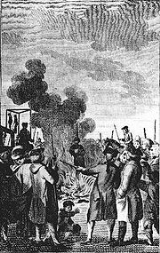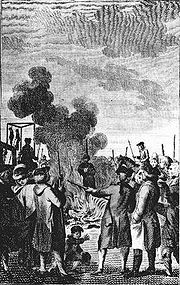
Malin Matsdotter
Encyclopedia

Execution by burning
Death by burning is death brought about by combustion. As a form of capital punishment, burning has a long history as a method in crimes such as treason, heresy, and witchcraft....
. She is also known as one of the last victims of the great witch hunt of 1668-76, which ended with her execution.
Context
Malin Matsdotter was an old Swedish woman of Finnish descent, one of many victims of the witch hunt hysteria called "Det Stora Oväsendet" (The Great Noise) in SwedenSweden
Sweden , officially the Kingdom of Sweden , is a Nordic country on the Scandinavian Peninsula in Northern Europe. Sweden borders with Norway and Finland and is connected to Denmark by a bridge-tunnel across the Öresund....
between 1668 and 1676. She was the only known witch in Sweden to have been burned alive: normally, the witches in Sweden were decapitated
Decapitation
Decapitation is the separation of the head from the body. Beheading typically refers to the act of intentional decapitation, e.g., as a means of murder or execution; it may be accomplished, for example, with an axe, sword, knife, wire, or by other more sophisticated means such as a guillotine...
before they were burned. Before this time, very few people had been accused of this crime in Sweden, but during these eight years, after the accusation of Märet Jonsdotter
Märet Jonsdotter
Märet Jonsdotter was an alleged Swedish witch. She is one of the most known victims of the persecutions of sorcery in her country; she was the first person accused of this in the great witch hysteria called "Det Stora Oväsendet" of 1668–1676, and her trial unleashed the beginning of the real...
, about 280 people, both women and men, were decapitated and burned as witches. The Swedish witch frenzy reached its peak with the Torsåker witch trials
Torsåker witch trials
The Torsåker witch trials took place in 1675 in Torsåker parish, Sweden. 71 people: 6 men and 65 women were beheaded and then burned, all in a single day...
, and it reached Stockholm
Stockholm
Stockholm is the capital and the largest city of Sweden and constitutes the most populated urban area in Scandinavia. Stockholm is the most populous city in Sweden, with a population of 851,155 in the municipality , 1.37 million in the urban area , and around 2.1 million in the metropolitan area...
with the Gävle-Boy
Gävle-Boy
The so called Gävle Boy, which was the nickname for Johan Johansson Griis, , was a young Swedish boy remembered for being a witness in witch trials and for bearing the large responsibility for the witch trial of Stockholm in 1676....
in 1675, where it lasted until 1676, and ended with the famous execution of Matsdotter.
In accordance with the rest of the witch trials in the great Swedish witch hunt of 1668-76, the witch hunt of Stockholm was mainly concentrated not on sorcery, but on the belief that the witches abducted children to the Witches' Sabbath of Satan
Satan
Satan , "the opposer", is the title of various entities, both human and divine, who challenge the faith of humans in the Hebrew Bible...
in Blockula
Blockula
Blockula was a legendary meadow where the Devil held his Earthly court during a witches' Sabbat. This meadow could only be reached by a magical flight. It was described as "a delicate large Meadow, whereof you can see no end".There was said to be a large gate located in the meadow that led to a...
. Malin Matsdotter was one of many people accused of having done this. Before her, five other women in the city had been executed for this crime, starting with the sisters Brita
Brita Zippel
Brita Zippel, also called Britta Sippel was an alleged Swedish witch, known as "Näslösan", one of the most famous figures of the great witch mania called "Det Stora oväsendet" in Sweden between 1668-1676, and the most famous of the city of Stockholm...
and Anna Zippel
Anna Zippel
Anna Zippel, also spelled as Sippel or Sippela was an alleged Swedish witch, one of the most famous ones of the witch trial of Katarina in Stockholm during the Swedish witch mania "Det stora Oväsendet" of 1668-1676; She was called "The Queen of Blockula", and together with her sister Brita...
.
Trial and Verdict
Malin Matsdotter lived on Mariaberget in Stockholm and was the poor widowWidow
A widow is a woman whose spouse has died, while a widower is a man whose spouse has died. The state of having lost one's spouse to death is termed widowhood or occasionally viduity. The adjective form is widowed...
of a man who was executed for sodomy
Sodomy
Sodomy is an anal or other copulation-like act, especially between male persons or between a man and animal, and one who practices sodomy is a "sodomite"...
. Her profession is unknown; she is mentioned to have been active as a midwife, but it is not known whether it was her regular profession She was accused by her adult daughters who claimed that she had abducted their children, her own grandchildren, to the Sabbath of Satan in Blockula
Blockula
Blockula was a legendary meadow where the Devil held his Earthly court during a witches' Sabbat. This meadow could only be reached by a magical flight. It was described as "a delicate large Meadow, whereof you can see no end".There was said to be a large gate located in the meadow that led to a...
. Malin cursed her daughters for their lies but was judged guilty by a unanimous court on the testimonies of her daughters. She refused to say farewell to them and refused to shake their hands. She stood stern in her denial before the court; such firmness was often considered to be a sign that the Devil helped his witch to withstand interrogations.
Malin was sentenced to be burned alive because of her refusal to plead guilty, despite the torture
Torture
Torture is the act of inflicting severe pain as a means of punishment, revenge, forcing information or a confession, or simply as an act of cruelty. Throughout history, torture has often been used as a method of political re-education, interrogation, punishment, and coercion...
she was exposed to. One of the previously accused, Anna Lärka, had also received the same sentence for her refusal to admit guilt but it was revoked when she finally did so. In the case of Matsdotter, the sentence was to be carried out. This caused a debate among the authorities, as this method of execution was very uncommon in Sweden; though several crimes stated public burning, this actually meant that the condemned be "executed and burned", which meant that they were first executed by decapitation or hanging, after which their corpse was publicly burned; the method of burning someone still alive is only known to have been used in the country a very few times before, and the verdict was therefore controversial.
No other person executed for sorcery in Sweden is confirmed to have been burned alive. It was also against normal practice to execute someone who had not admitted their crime. One suggestion was, that at the place of execution, she would be given a last chance to confess her sin; if she did so, she would be decapitated before she was burned. One member of the commission suggested that she be tortured with hot irons before the execution, so that she would be unconscious and not aware of the pain, but the suggestion was revoked with the view, expressed by a priest, that the honor of the name of God was more important then Malin's personal experience of pain; the method was also deemed necessary as an example to the public and to her accomplices . She was instead,to have a bag of gunpowder
Gunpowder
Gunpowder, also known since in the late 19th century as black powder, was the first chemical explosive and the only one known until the mid 1800s. It is a mixture of sulfur, charcoal, and potassium nitrate - with the sulfur and charcoal acting as fuels, while the saltpeter works as an oxidizer...
secured around her neck to make her death quicker.
Execution
The execution was carried out in the square of HötorgetHötorget
Hötorget is a city square in the center of Stockholm. During the daytime it is the site of a fruit and vegetable market, except on Sundays, when flea markets are arranged....
in Stockholm on the 5th of August 1676. Malin was to be executed with another woman, Anna Simonsdotter Hack, called "Tysk-Annika", who had also been accused and sentenced to death on the testimony of her own children. Anna Simonsdotter was to be decapitated the usual way before burning, and the differences in their behavior have given Malin the admiration of history.
Anna Simonsdotter stepped up to her execution with great humility, full of respect for her judgment; though she did not directly say that she was guilty, she behaved as was expected of her, and "by her remorse, by her psalms, and by falling on her knees and lifting her head and her hands to the sky, confirmed the justice in the verdict and the justice in the world". Malin Matsdotter, on the other hand, described by witnesses as proud and firm, received the gunpowder with a smile and climbed up the stake showing no fear, talked calmly to the executioner and let him chain her by her hands and her feet without fighting back. She talked back to the priests with her head held high when they pleaded with her to acknowledge her sin, maintaining her innocence. Standing at the stake, she once again stated her innocence. When one of her daughters, who were the ones who had accused her of witchcraft, called out from the audience for her to admit her crimes to save her soul, "She gave her daughter into the hands of the devil and cursed her for eternity". After this, the fire was lit.
Aftermath
It is said that she died with no pain and without screaming which was taken as another proof of her guilt, as it was believed that witches could not feel pain. This was the end of the great witch trials in Sweden; soon afterwards Judges, led by Urban Hjärne and Eric Noraeus, began to express their skepticism toward the child-accusers and witnesses. On 11 September 1676, one of the witnesses broke down in court and was followed by the others.The rest of the accused witches were set free, and three of the main child-witnesses, the Gävle-Boy
Gävle-Boy
The so called Gävle Boy, which was the nickname for Johan Johansson Griis, , was a young Swedish boy remembered for being a witness in witch trials and for bearing the large responsibility for the witch trial of Stockholm in 1676....
and the Maids of Myra, were arrested and executed instead. Several of the other witnesses were whipped for their perjury. One of the perjurers who was executed at the end of this year was the daughter of Malin Matsdotter.
In 1677, all the priests of the country were ordered to tell their congregations that the witches had now been expelled from the country forever to avoid further witch trials. This ended the great Swedish witch hunt of 1668-76. Though there were accusations after this, few people were executed for sorcery after the year of 1676. The last execution for witchcraft took place 1704 when Anna Eriksdotter
Anna Eriksdotter
Anna Eriksdotter or Anna Ersdotter, , called Sotpackan was an alleged Swedish witch. She was the last person to be executed for sorcery in Sweden.-Background:...
was decapitated, the last person to be executed for sorcery in Sweden.

